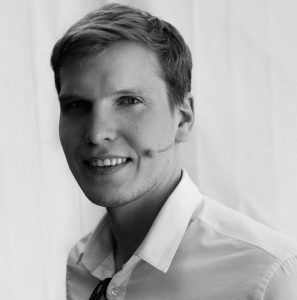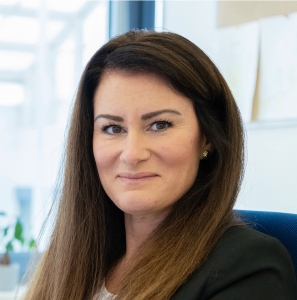Rainer Hirt, thank you very much for being with us today!
It’s my pleasure, thank you very much for having me.
You’re very welcome. Why don’t you start by telling us a little bit about yourself and about audity?
I’d be happy to! My name is Rainer Hirt and I am the Managing Director of audity GmbH. We are based at Lake Constance, are a very small team of seven employees and have been working on the topic of “How do brands sound, how do user experiences sound?” for 15 years. My background is actually not music at all, but design. I studied communication design, but during my studies I quickly turned to sound design as my personal guiding theme because of my musical background. And that’s what I’ve been pursuing for 20 years now, and just for 15 years with audity.
Wonderful, thank you very much for that little introduction! When it comes to brands or logos, most people tend to think of visual logos; what role does sound play in the area of brands?
You have to imagine that as a human being you don’t only have the visual channel – we are permanently in recording mode, not only acoustically but with all our senses. The sense that is actually the hardest to switch off is certainly the sense of hearing. I can’t listen away – I can look away if I don’t like something, I can close my eyes, but I can’t close my ears, and that of course leads to the very obvious question: if that’s the case, why shouldn’t you as a company, as a brand that is already acoustically present in quite a lot of media – telephone loops, podcasts, videos – use the sense of hearing strategically as a communication element for the brand?
And here, one element – the sound logo – is of course super suitable – although in recent years, people are increasingly moving away from the focus on a pure sound logo, towards more holistic systems. By that, I mean that people are also thinking about how to introduce recognition within the music – intros, outros, down to the small minimal sounds that you perceive in digital products, for example: when you open the app, a pop-up sound or a notification sound. There are great examples such as Slack, Facebook or Twitter: all these companies are using these little micro-interaction sounds as recognizable features and these are actually the new sound logos. That means we’re living in a time where the sense of hearing is becoming more and more important, where you simply can’t avoid asking yourself as a brand or as a company: “What do we actually sound like as a brand? What is actually our language, our voice?” And that’s why sound logos are so important.
When you create sounds for clients, what does this process look like? For example, what role does the medium, the target group, etc. play?
We always start with the question of meaning. When we get the project request in or when a project starts, we always look at the whole context. We look at the company, the brand, the products, everything that is present in this system, so to speak, and ask ourselves the question, “What is actually the raison d’être of a sound within a system? What value should the sound generate?”
We don’t just start strumming away or recording sounds and recording voices, but we take a very close look at the brand and its identity. What is the brand’s core message, how should the brand be perceived by customers? If we know, for example, that emotionalization is a very important point or that creating a sense of security is a function, then we know that these are the foundations for the future sound. Then we start to translate the meaning – meaning here means: how can we translate sound patterns from everyday life into brand sounds in a relatively simple and understandable way?
I’ll try it with a very concrete example: When it comes to a brand that has a lot to do with power tools or that manufactures power tools, it makes sense to also take a sound from the power tool world and perhaps coin that for this brand. We have a customer where we did that, for example. Then it’s a matter of: how can you derive a melody, how can you generate a rhythm, a reduced perception, a recognition that can then actually be scaled to all products and to all areas of application?
For example, it doesn’t make sense for a company whose devices work with piezos – i.e. small sound generators that can only make “beep beep” – to define a sound that can’t even be represented on these devices. That’s what we think about: what is the appropriate idea for the context, for the product world? At the end comes the aesthetics, the instrumentation, the concrete artistic interpretation of this idea. All in all, that’s the rough framework of how we proceed: first answering the question of meaning, then translating the meaning, and finally giving it all an aesthetic form.
You mentioned that you see a development from sound logos to a holistic sound concept. Where do you see the journey going in the coming years?
I think there is a general trend that you can perceive: the topic of adaptation, adaptive design, systems that adapt to us humans as users. I think that will also be a trend in sound or brand sound, audio branding, sound branding, whatever you want to call it. That means that advertising, for example, will be individualized.
If we refer to the topic of user interfaces, the systems will probably remember what the user’s preferences are, whether it’s a young person or an old person, an introvert or an extrovert, whether the sounds need to be louder or softer. Accordingly, this person also reacts sensitively to different tones, sounds, to the different voices and that’s where the journey is going, that the systems are becoming more intelligent, more adaptable and I think that’s the huge trend or the big development that we’re facing over the next 10 years.
You originally came from a design background and then moved towards sound. What fascinates you about brands and sound, how did you find your niche in this area?
It started very early for me. Even as a child, brands always fascinated me. There was one key element. I was seven or eight and I really wanted an Air Jordan T-shirt. My parents said, “Nah, it’s too expensive.” But I was so excited about Michael Jordan and the NBA and this sign and the fact that you can make a brand out of one person and at such a young age, it didn’t let me go. I created my own logos relatively soon, simply because I was so fascinated by this topic of brands, because I was fascinated by how you can coin a symbol, a visual sign – and later also a musical sign – for something and achieve something with it, create a symbol, so to speak.
People are simply symbol-oriented. That’s how it developed for me relatively early on. When the topic of design came up in my studies, the topic of “translating meaning”, and me making music myself from an early age, it sparked this combination of “you can also represent a brand acoustically”, which was such a eureka moment. That’s when I said, “Awesome, I kind of want that, I want to pursue that, that’s mega exciting.” And I understood relatively quickly what a brand is: it’s not just an Air Jordan sign, it’s a person, it’s a voice, it’s a complete appearance. And then it dawned on me that brands also get an identity through sound. I found that so fascinating that I said, yep, this is my niche. That’s where I want to place myself, that’s where I want to develop something, do pioneering work – that’s always been my approach.
You say your enthusiasm for brands started at a very early age. What was your favorite brand in your childhood and what is it today?
It was actually Nike, Air Jordan – the jumping Michael. That was the first brand I consciously noticed. Today, I have to say, I’m fascinated above all by young brands that manage to present an identity within a very short time that doesn’t seem forced, that is totally fresh, that is new, that is zeitgeisty. I’m a big fan of crypto and I find it mega exciting, for example, what’s going on in the field right now – how neobanking, how neobrokers are setting themselves up, whether that’s companies like Trade Republic or BitPanda from Austria. A brand from a completely different area that I really appreciate is Lilium, an airline company. They don’t see themselves as an air cab, they see themselves as a company that will eventually become an airline. Those are brands that I find insanely fascinating because you get to be there at the birth of that brand and in the infancy of that brand.
Another example: I followed Airbnb relatively early and was in contact with Brian Chesky back when it was still called AirBed & Breakfast. I caught on to that at the time and found that fascinating: “Oh cool, there’s a Couchsurfing competitor!”. I think that’s exciting. Couchsurfing and Airbnb were peers, and Brian Chesky and his partner managed to create a brand through design. Through design decisions, through photography decisions, decisions about how video can play a role, in the end how music can play a role, they built a mega platform out of that, which of course is still insanely exciting to watch today. These are the brands that fascinate me. So it’s not even the established brands, traditional brands – it’s also exciting to see how they hold their own – but it’s above all the young plants, where you can watch them grow up from childhood to adolescence. I find that fascinating.




